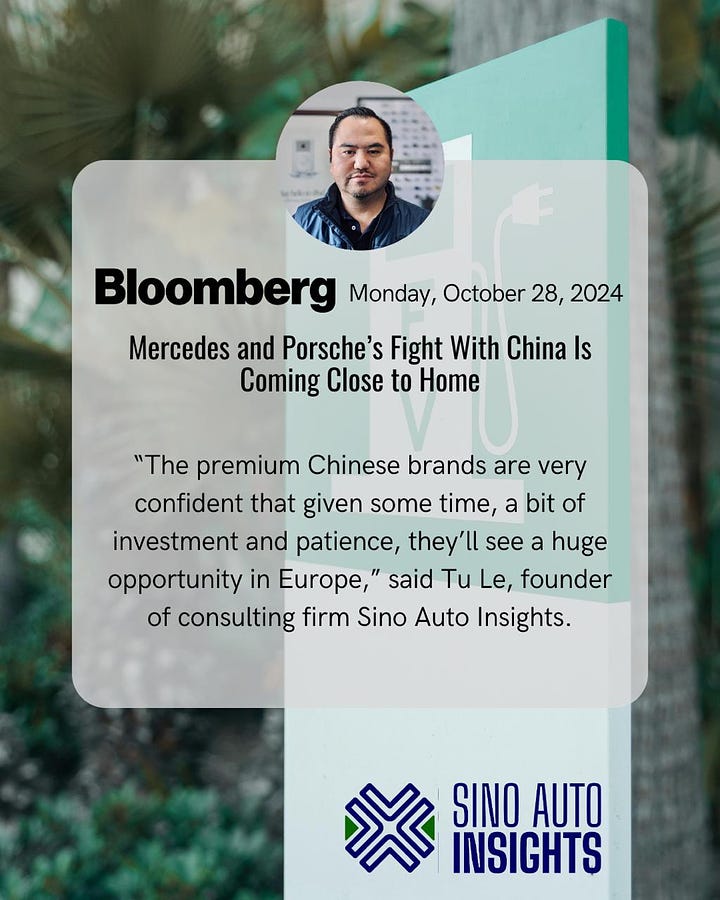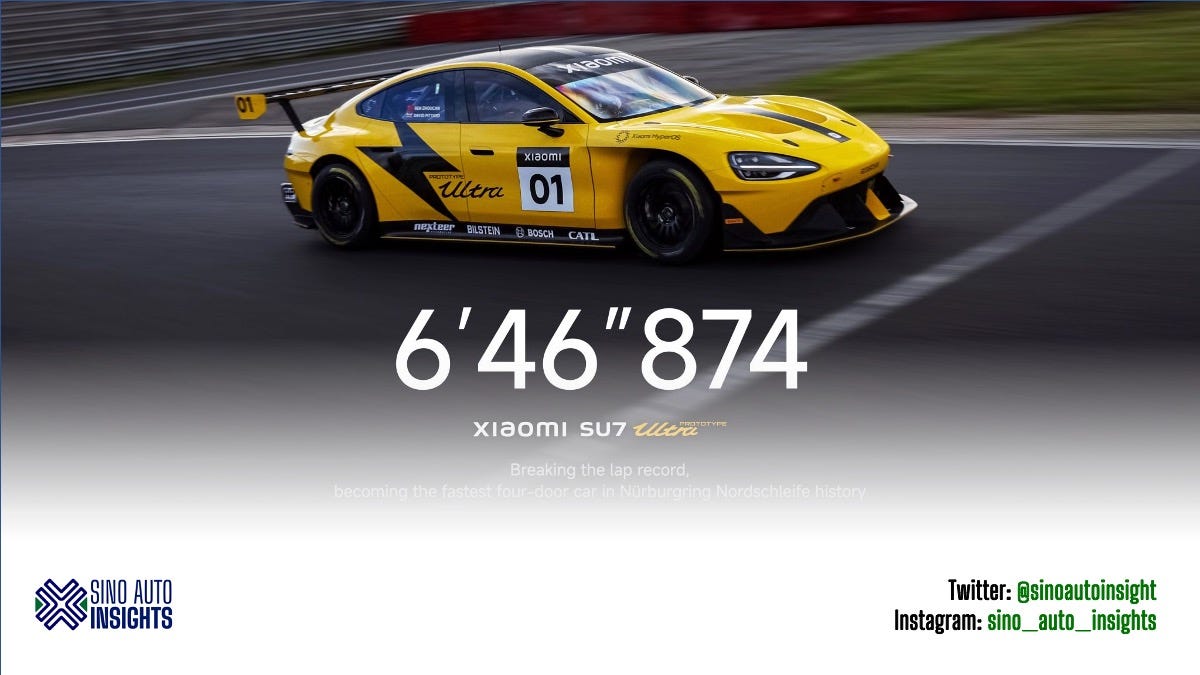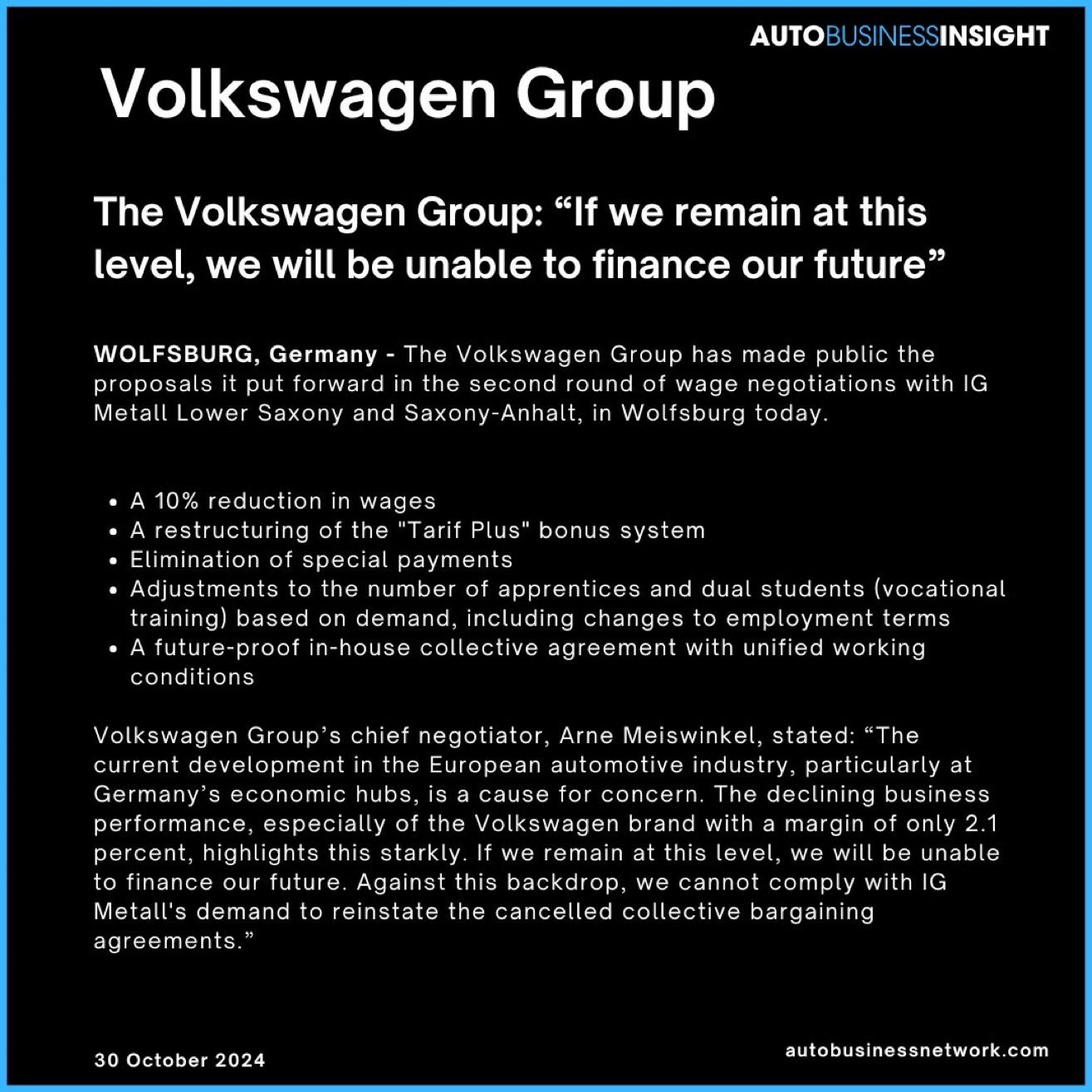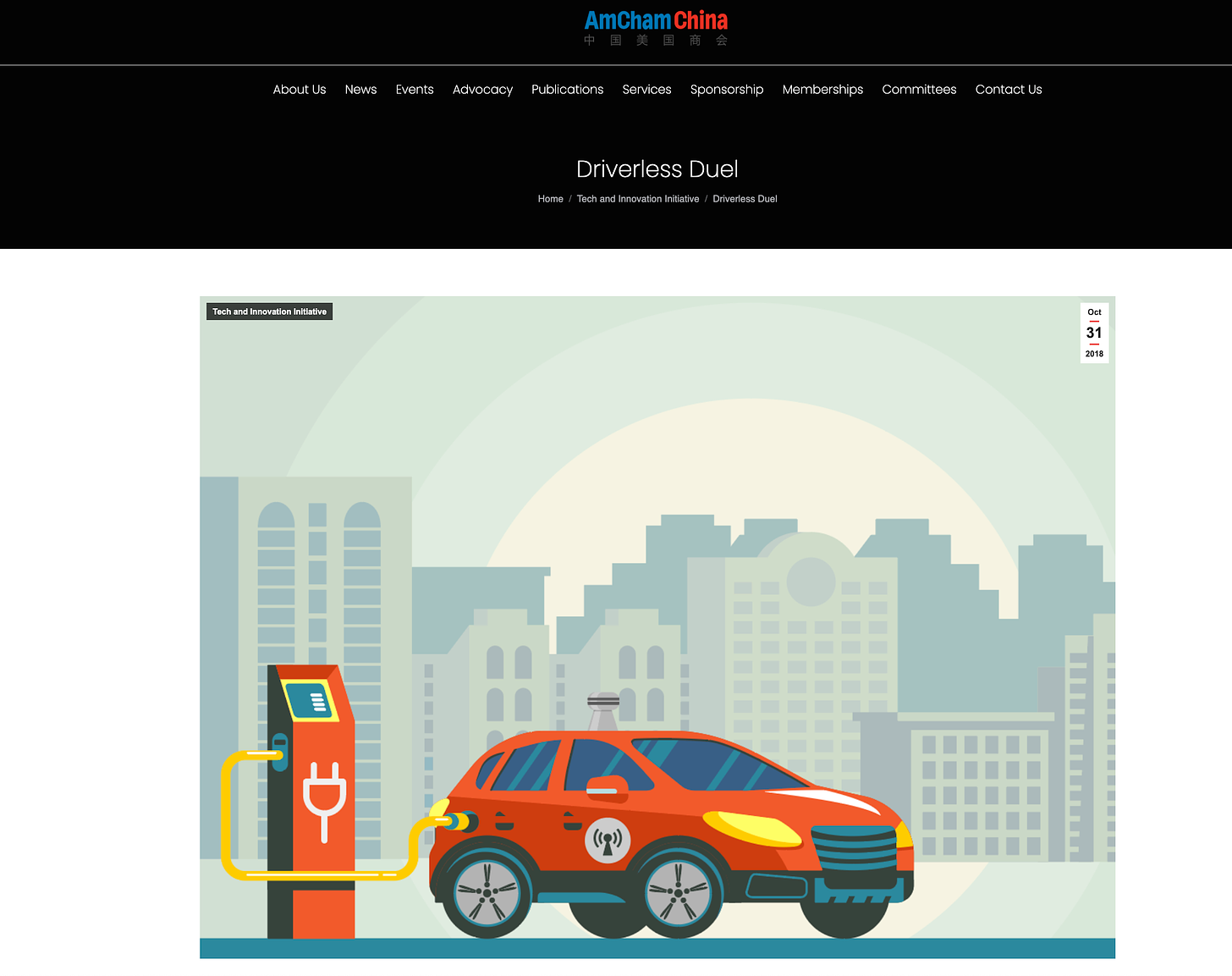SAI Weekly 38 - 24: Stellantis & VW Lobbying (in the Media) to get (much) Smaller, BYD Overtakes Tesla, My Thoughts from 2018
China EV Inc, continuing to break records. This time the Xiaomi SU7 Ultra broke the lap record for a 4-door sedan. Ironically, it dethrones the Porsche Taycan, the car that it was largely (externally) styled to mimic Some say too much so. This is obviously normally the domain of the Germans and around the internet there are many qualifiers about this car not being a production car and being equipped with one-off components that allow it to record such a ridiculous time.
Let me remind everyone, the Xiaomi EV division was ONLY announced in September of 2021! That means they’ve been able to design, develop and launch a vehicle and build up an order book over >100K in just over 3 years. I am not sure that ANY legacy automaker, even with the all the resources they have available to them, would be able to do that.
If we’re looking at the glass half empty though, are the days of German performance being superior in the automotive space over? It sure seems like it now that Lucid, Tesla and Xiaomi ALL have vehicles that go from 0-60 in < 2 seconds. I’ve been in two of those vehicles BTW.
And that entire argument that these fast EVs aren’t fun is complete B.S. If you still like the ICE vehicles even though they’re slower and perform worse, you actually don’t like speed, you like nostalgia. That’s OK, just admit that.
___
And we are LIVE. The EU tariffs on China EV Inc that is.
Today is more symbolic than anything since we knew about these tariffs for quite some time and I would’ve been shocked had the European Commission made any meaningful reductions / eliminations to the tariffs rates that had originally been proposed. There were very small reductions made to a few of the rates, but for all intents and purposes nothing meaningful.
Not that it matters since the China EV Inc strategy for entering Europe already has most of this baked in. That said, it’s NOT pushing them off entering the market – in fact, for companies like BYD & Tesla, both of whom got slaps on the wrist when compared to their counterparts, they will likely try to be more aggressive with their plans for Europe.
For BYD, there’s the added bonus of PHEVs being omitted from the tariffs which creates an enormous opportunity for them. Not ever resting on their laurels, my expectation is that they’ll likely push hard to get vehicles built locally within the next 18 months. They will grind and make sure that suppliers meet THEIR timelines – so this could be the next major area to keep an eye on. China 9-9-6 vs. Europe’s 35-hr work weeks. 35 hours ain’t gonna cut it. I promise you that.
Think about the old GM factory in Fremont, CA. It was famously one of the least productive factories for GM when it was in operation from 1962 – 1982.
It became a Toyota / GM joint venture from 1984 – 2010 called NUMMI and for years it was one of the most productive factories in the world. Using many of the same union employees that the GM factory did.
A small EV startup called Tesla acquired that factory in 2010 for a song. A song called $42M. The state of CA kicked in another $15M in incentives to get the factory up and running. Job #1 rolled off the line on June 22nd, 2012. We are seeing history in the making the rest of the way.
Will BYD and for that matter, China EV Inc’s hard charging relentless work culture export? That remains to be seen, but either way there will be growing pains from adjusting to a new culture, norms, laws, regulations, work styles, suppliers, transportation methods, languages, quality levels, etc., but BYD will find a way.
And for those European cities they decide to manufacture in, this could be a factory that could be around for 25 – 30 years if not more, employing thousands of people directly and tens of thousands indirectly so why wouldn’t you want them to come?
Contrast that with the current situation for Stellantis and VW Group that I’ll get into more detail down below and they could effectively replace lost jobs from the Legacy Automakers.
Finally, there’s risk on the EU side. The countries that voted for the tariffs, namely France and Italy can bet on some form of retaliation including Chinese brands not building factories in those countries and tariffs on exported goods from those countries into China.
But there’s risk on China’s side as well since they still want foreign direct investment from European companies and any retaliation deemed too harsh may push away that investment. Another consequence of retaliating too harshly - Europeans may reject Chinese EVs as their own way of protesting.
The BIGGEST uncertainty now should be (hopefully and peacefully) settled before the end of next week, who the next US President will be. Having the 2nd largest passenger vehicle market off limits makes the EU market and its consumers that much more important. Will the next President dial up or down the US protectionism? That remains to be seen.
CHINA EVs & MORE
Below is last week’s episode where we go over Tesla’s earnings, the WeRide IPO and much more. I invite you to spend a few minutes to be informed and entertained.
We will be broadcasting LIVE again on Friday 9AM ET for those interested in joining the show.
INTERVIEWED / QUOTED


Link to the WSJ article is here.
Link to the Bloomberg article here.
BIGGEST NEWS THIS WEEK
BYD outsells Tesla …by revenues. The Tesla STANs will all point to sales numbers which BYD still haven’t overtaken on BEVs alone which is fine. BYD will take that crown from Tesla likely within the next year. Then what Tesla STANs? What statistic will you point to next so you can try to keep Tesla’s lofty valuation where it is? I’ll be waiting.
Also worth mentioning about BYD - they hold a 33% share of the NEV sector in China. 1 of every 3 NEVs in China has a BYD, Denza, Fang Cheng Bao or Yangwang badge on it.
___
Stellantis milked it when the going was good, but now that chicken has come home to roost. Their price increases finally hit a ceiling with customers rejecting the eye watering prices being charged for Grand Wagoneers, Jeeps and Grand Cherokees which has caused inventory of some pretty expensive products to balloon.
Stellantis is targeting a reduction in inventory to 330K by the end of the year – they reduced inventory by about 50K units in Q3. With too many cars in inventory, that means factories are being shuttered, at least temporarily in MI & OH in order to bleed this inventory to more manageable levels.
Let’s do a quick back of the envelope calculation. In 2023, the average passenger vehicle price in the US = $48K so that means Stellantis is targeting a reduction TO $14.4B in inventory by the end of this year! WTF??
Sales are down 20% YoY if you’re wondering how the inventory was able to balloon to that level. This should be a MAJOR concern for Stellantis and this points to Stellantis being very greedy when the getting was good.
Carlos tries to clean up a mess that he had a hand in creating and tries to protect his likely last couple enormous paydays as he walks out the door. He looked pretty happy to me in Paris when he presented at the LeapMotor presser though.
___
VW Group wants to go bigger – as in shuttering (at least) three factories instead of one. This could affect tens of thousands of workers in Germany. And is an example of the dire straits that VW is in with regards to their inability to compete. It’s also going public with some of its goals for the negotiation (thanks to Greg Cable for posting this on X)
One important counterpoint I’d negotiate if I were the Works Council - VW Group executives stepping down from the management board. Specifically those that were behind the wheel of the China mess.
If we think about it - the team that drove VW Group into the Diesel-gate ditch remained largely intact. Now they’ve driven them into an EV ditch. When will managers be held responsible for their lack of vision and understanding of key markets, products and global trends?
I am tired of management teams negotiating ‘retention’ bonuses - Dude. You got us into the storm, why would I want you steering the boat when I am trying to get out of it. Alas, many managers are able to negotiate themselves into a better position in times of crisis when they should be swiftly shown the door.
Honestly, if you want executives that manage companies into existential crises, there are MANY (un)qualified personnel around the world able to do that.
Let me be clear. I have no confidence that the current management, even if they are able to negotiate significant concessions from the unions and government, can right the ship. How will they do this when they have no backgrounds in the areas where the automotive and transportation spaces are headed. Namely, AI, SW development and services.
Let me be clear, clear. Automotive manufacturing will largely be commoditized within the next 10 years.
For the VW Group HR and recruitment teams - I would consider taking a role in the management team, it’ll be VERY expensive and I’d like to have a private jet that takes me from Silicon Valley > Detroit > Wolfsburg > Stuttgart > Beijing as needed. Oh, and I’d like my pick of a few Porsches for my garage.
What gives me the credibility to write something like this? Besides having worked in Detroit, Silicon Valley and China for Chinese startups - Can you think of anyone else that was writing about the reckoning that was coming to the automotive space …6-7 years ago? Yeah - Not Bill, Michael nor Matthias.
Further proof - this is what I wrote for the American Chamber of Commerce in Beijing …in 2018!
___
The automotive sector is in the early stages of reinventing itself, with incredible changes being driven by advancements in artificial intelligence and the increasing popularity of electric vehicles (EVs). At the same time, innovative companies such as Didi, Uber, and Grab have fundamentally changed how people get from A to B, and transformed our collective views on personal mobility. The development of electric and autonomous vehicles (EV/AV), when combined with the growth of the ridesharing sector, has resulted in both competition and partnerships between traditional automotive companies and technology companies. The two sides are now forced to coexist as “frenemies”, as they co-develop products and services together in the race to “Transportation 2.0” global leadership. And while they must collaborate, the competition between the two sides is only getting more intense.
It could take another 20 years before we see a critical mass of people shift to driverless cars. But the anticipation of that day is such that, within the last five years, hundreds of EV startups have popped up – particularly in China – all looking to build alternatives to the traditional internal combustion engine (ICE) cars. Carmakers are also betting on an electric future, by launching their own products, these EVs will be the bridge to autonomous vehicles (AVs).
Positive Outlook
The Chinese government has decided to firmly support their country’s move towards EV/AVs and has already taken a leadership role globally. Once automotive and technology companies learn to trust each other, they’ll be able to work together to monetize opportunities resulting from the data provided by these EV/AVs.
Elsewhere, alongside increasing investment and growing interest from consumers, the outlook for the industry as a whole looks increasingly positive. The Chinese government has created an optimal environment for the development, production, and sales of EVs in China. Over the last few years, Beijing has prioritized tackling pollution, securing energy independence, and achieving technology dominance. Combined, these three initiatives have created an environment for promoting the mass adoption of EVs in China. Investment by the government, both at the national and local levels, as well as subsidies in the form of land and tax abatements and through rebates on EV purchases, has also helped EVs take a huge step forward while incentivizing Chinese entrepreneurs to launch their own EV startups. Many entrepreneurs have done just that, with the Wall Street Journal estimating that there are currently 487 EV carmakers in China.
There’s an argument that the coal-powered electricity that is used to power EVs in China means that these cars are no better for the environment than the ICE cars they’ll be replacing. That’s partly true, but as solar and wind power becomes a larger share of energy creation, energy storage capabilities continue to increase, and smart grids become more commonplace, the use of coal for effectively powering EVs will shrink, and they will clearly become a better alternative for the environment.
But can the Chinese EV startups that emerge from the pack plot out a roadmap to success? Sales of New Energy Vehicles (NEVs), which comprise EVs + plug-in hybrids, are forecast to rise nearly threefold in China by 2020, from 777,000 in 2017 to more than two million. This will have a multiplier effect by reducing costs across the board for EV parts, specifically for batteries – the most expensive part of an EV. These domestic trends will bring the price of EVs down globally, which is why Bloomberg New Energy Finance forecasts that EV sales will reach 11 million globally by 2025 and 30 million by 2030.
This is another big reason why investment has poured into the EV segment and created so many EV startups. However, most of them are in the early stages of development, and many won’t even make it to prototyping as funding typically gravitates towards the companies with the best management teams. If we assume that only 10% of all EV startups will survive the next five years – a generous assumption – that would mean about 50 EV companies will have carved out a piece of the EV pie in China.
EVs are just beginning to go on sale en masse, but, by 2019, many different manufacturers, including the traditional German, American, and Japanese carmakers, will have each launched multiple EVs. These new models will be affordable to a large part of the market, and, by 2025, people all over the world will have plenty of options at different price points.
China’s Autonomous Policy Edge
Although some current vehicles can park themselves and even drive on highways autonomously, the wide adoption of AVs and Level 5 Autonomous Driving – no steering wheel, gas, or brake pedal – is still quite a long way off due to regulatory, insurance, and infrastructure issues. Insurance companies are still studying where liability should lie in the case of car accidents caused by AVs. In the US, individual states will have the right to regulate AVs, creating a complexity that’s not found in other countries. Given its streamlined, top-down policymaking, it is likely that China will be at the forefront of determining how to deal with AVs and the risks associated with them once they hit the road in large numbers.
Artificial Intelligence (AI) companies that are developing the software to literally “drive” AVs have been collecting data to feed their AI systems for quite some time already. AVs are not yet a safer alternative to human driving, but autonomous driving can still be a differentiator for many EV companies. Developing AV hardware and software is where most of the technology companies want to carve out their piece of the pie, and both carmakers and tech companies want to make AVs a key component of future ride hailing and ridesharing services they themselves will roll out. There is a lot at stake: Goldman Sachs predicts the global ride hailing market alone will be worth US $285 billion by 2030. If the Ubers and Didis of the world don’t have to pay someone to drive their vehicle, they get to keep more of that customer’s money for themselves.
Cut From a Different Cloth
As someone who has worked for both technology companies and automotive companies, I can tell you that they think totally differently. For instance, from a financial investment standpoint, tech companies think in terms of operating expenses. Since many don’t have a physical product, or outsource manufacturing when they do, every expense incurred for them in support of the new products or software is recognized in the same period in which it has been incurred. Meanwhile, car companies typically think in terms of capital investments. Investing in a brand new assembly plant can easily cost over US $1 billion, which needs to be amortized over a number of periods, normally 60-120 months.
Another example is the difference in the length of the product lifecycle, which for many tech companies is usually between 9-15 months. For an automaker it can be up to five years, meaning that they need to be much more cautious when making decisions, since their capital could be tied up for a far longer time in comparison.
It could be a current automaker and tech partnership, or a brand-new startup that ultimately develops the products and services that are convenient, feature a terrific user experience, and at price points that attract the average consumer. But, until then, the learning curve will remain very steep. However, there are certain ways that the traditional car firms and the newer tech companies can collaborate in order to move the needle – a necessity as currently neither is able to bring to market a complete hardware and software solution at the level of Transportation 2.0.
Advice from the author
Automakers
You’re still moving too slowly. These technology companies need you – for now. Once they’ve determined you no longer add value to what they’re trying to accomplish, you will be replaced by a cheaper, easier-to-manage commodity.
Take the time to learn more about the other side; how they do what they do; and how you can use their tools, smarts, and speed to help you build something dynamic that is going to dominate the market. Otherwise, they will leave you behind.
The time for thoughtful, time consuming evaluation and analysis ended last year. Match the tech companies’ ability to analyze data, speed in decision-making, and execution or be prepared to have them eat your lunch.
Tech firms
Electric vehicles are not the same as bikes or scooters that can be strewn messily across cities, whether it’s China, Europe, or the US. There are much higher stakes involved – including people’s lives. Not all problems can be solved by using a math equation.
The systems integration skills of automakers are some of the best in all of business. Just because they can’t make it as pretty or user friendly as you can, doesn’t mean they don’t have anything valuable to provide.
A Ford F150 uses about 150 million lines of code, close to double that of Mac OSX Tiger, so don’t write the car guys off as technological dinosaurs just yet!
Here’s a link to the article: https://www.amchamchina.org/driverless-duel/
___
Mexico is considering tariffs on China too. But on e-commerce goods from sites like Shein and Temu. The US is also looking to close a loophole that currently allows for ‘de minimis’ shipments of <$800 to be shipped duty free. Those same sites take advantage of that US rule to ship goods directly from China free of taxes.
The Mexican economy is running a deficit so this is a way for the new President to increase revenues and if this works, can tariffs on Chinese vehicle imports be far behind? Remember, not many EVs yet in Mexico, but ICE imports are increasing from China. They’re not just from Chinese companies though. GM and other legacy automakers ship vehicles from China so that could have negative impacts on the legacy automakers as well.
BY THE NUMBERS
- 30%, -13%, -19%, -15% - These are the Q3 YoY sales decline percentages from: BMW, Mercedes, Porsche and Volkswagen Group. This is on top of the losses from 2023 AND despite price cuts from each automaker. If you can believe this, Porsches are now being discounted, even the 2023 911s I am being told.
- $8.5K. Mini Cooper E Fire Sale. Originally priced at ¥209,800 ($29,542), it’s now going for ¥148,800 ($20,950) - this is a 30% discount! If that price was in the US, there’d be one in my garage.
_________________
This weekly newsletter is a collection of articles we feel best reflect the happenings of the week or important trends that have effects on the global automotive and mobility sectors. We also provide a point of view that we hope educates and sparks debate.
The Sino Auto Insights team








I'd like to read a piece about the level of (CCP) government assistance that these established/emerging NEV manufacturers attract. Startup. Ongoing. Permanent.
The standard put down of the Chinese is that 'they are all funded by the CCP' (using stolen IP?) and therefore should be taxed in order to 'level the playing field'.
What IS the reality ?.